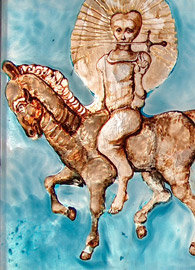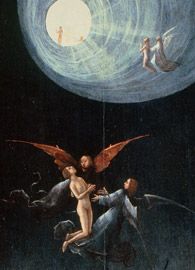Revelation Week 10
The Apocalypse of God’s Salvation Come to Earth (Revelation 19:11–20:15)
By Rob Wall
Seattle Pacific University Paul T. Walls Professor of Scripture and Wesleyan Studies
Read this week’s Scripture: Revelation 19:11, Revelation 20:15
18:23

 Enlarge
Enlarge
Speaking as a fan of professional baseball, I think one of the great traditions of the game takes place when the home team’s best relief pitcher enters from the bullpen in the final inning to close down the visiting team and secure the victory. Depending on the city and team (Seattle is a laidback city, and its grand entrances can seem tame by comparison), the pitcher’s anthem blares and the scoreboard flashes his most memorable highlights to work the crowd into frenzied anticipation of yet another conquest. The specific song that announces a pitcher typically calls attention to something memorable about him — perhaps his native home or his nickname. The light and sound show makes for the grand entrance of a fan favorite who comes in to win the day.
The Grand Entrance of an Inevitable Victor
There is hardly a more stirring entrance in Scripture than the one made by the warrior who rides from heaven on a white horse and whose nickname is “Faithful and True” (Revelation 19:11). His spectacular entrance befits his native home and the name given him because it anticipates what soon becomes evident: the seemingly invincible armies of earth, who support the reign of terror led by the two beasts of an unholy trinity, simply can’t handle the truth! The lies and deceptions that gained them worldly power (cf. 12:9; John 12:46–49) come to destruction by the sharp sword that comes from the rider’s mouth (19:15, 21; see below). Gospel, people, gospel: truth will win out because God’s kingdom is the real world.
John’s visions written down in Revelation narrate three grand movements that plot the history of God’s salvation: the past results of Jesus’ faithful witness and sacrificial death (5:1–11:19), the present tribulation (and sometimes martyrdom) of his faithful disciples (12:1–14:5), and the future victory of a faithful God who will deliver on the promise of “the eternal gospel” (14:6, NIV) to save the world from evil (14:6–19:10). This story is told with the confident awareness of evil’s passing yet persistent presence on earth. Finally, after hearing a sequence of angelic voices declaring Babylon’s self-destruction, heaven now reopens (19:11), and John sees from multiple angles and in rapid-fire succession (19:11, 17, 19; 20:1, 4, 11, 12; 21:1, 2; cf. 21:22) the final passing of evil’s reign on earth — what the prophets call “the day of the Lord”(cf. Joel 2:1–2; 3:9–21; Amos 5:18–20; 9:11–15; Zechariah 1:14–15; 2:7; 14:6–9; Isaiah 4:2–6; 30:26; Hosea 2:18–23; Micah 4:6–8).
John’s first sighting is of an impressive rider who makes his grand entrance on a white horse. He is called by several names, all apropos of his mission: “Faithful and True,” “Word of God,” “King of kings,” and “Lord of lords” (19:11–16). The rider’s names identify him as the risen Jesus, and they announce his return to earth to complete his messianic mission, even as his entrance as the newborn son of Galilean peasants anticipates his initial mission as God’s suffering servant. What is so striking about John’s vision of the Lord’s return is its uncommon mixture of kingly, military, and legal names and images.
The Evocative Names of the Victorious Christ
He is known first of all as “Faithful and True,” the marks of the able jurist who honors the truth and “makes war justly” (19:11). Jesus’ role is no longer faithful witness to the truth about God (see 3:14); he is now judge and jury whose just verdict is executed, whether to destroy the destroyers of earth or to vindicate the faithful martyrs who have begun to gather for the wedding banquet of the Lamb (19:6–10). The witness of Jesus by the “spirit of prophecy” (19:10) is now realized.
As a warrior, Jesus returns to earth not with sword in hand but with sword in mouth “that he will use to strike down the nations” who support the devil’s reign of terror (19:15; cf. 19:21). His second name, after all, is “Word of God” (19:13), which is the apostles’ witness of Jesus (1:2, 9; cf. 20:4) now proclaimed as our gospel (cf. 1 John 1:1–4). The final battle between good and evil is not waged with conventional arms but with unconventional, prophetic words — true words of God (21:5; 22:6) about a slaughtered yet risen Lamb that turn the world upside down and inside out (cf. Acts 17:6). The blood dripping from his robe is his own (19:13); no other bloodshed is necessary (cf. 19:20).
The risen Jesus comes back to rule the nations with an iron rod (19:15). Appropriately, then, a third name is given him: “King of kings and Lord of lords” (19:16). And literally so, since Jesus’ return evinces that he is the one and only King over all the nations’ kings and the one and only Lord over all those other pretenders that populate our public squares. The detailed description of the rider’s kingly wardrobe recalls things John has already envisioned that signal a great reversal. For example, the white horse that carries “Faithful and True” is seen earlier carrying another rider, whose mission is to deceive the world by the false premise that military might makes right (cf. 6:1–2; see Lectio 5). The two-edged sword that John earlier sees coming from Jesus’ mouth (1:16) — a sword that cuts two ways to tell the truth but at great cost to the one who wields it — now is a “sharp sword” (19:15) that delivers a single, decisive blow against the enemy. And the fiery eyes and crowned head that confirm the royalty of God’s Son (19:12; cf. 2:18) at the same time expose the false pretensions of the beast for all the world to see (cf. 12:3; 13:1).
He arrives with “heaven’s armies” in tow, dressed in white and riding white horses (19:14). They might be a troop of invincible angels, which would agree with Jewish depictions of the final battle. More likely, however, this is an army of the Lamb’s disciples (see 7:9, 14) — the “dead in Christ” as Paul calls them (1 Thessalonians 4:13–18) — who followed him wherever he went (cf. 14:1–5) and now return with him as witnesses. Their faithfulness has made them fit for the final battle.
Evil’s Demise
The terrifying exercise of God’s sovereignty over those kings and generals who dare to contest the gospel’s truth (19:17–21) draws upon Ezekiel 39:17–24 for its gruesome depiction of evil’s end. The presence of vultures “flying high overhead” signals a feast of death (19:17). Of course, this vision parodies God’s other “great supper” (19:17), which is the banquet prepared to celebrate the wedding of the Lamb and his bride, the Church (19:6–10). The forces of the two beasts muster with their kings under the direction of their generals to fight the forces of the warrior-Lamb in the final battle of Armageddon (19:19; cf. 16:12–16). We have our popcorn ready for a Hollywood–style apocalypse, but what a colossal downer we actually read! Before the battle even begins, the two beasts are captured and thrown alive into fire (19:20; but 20:11). [Author’s Note 1] Ouch!
Remember that these beasts are personifications of the evils that shape our daily lives in the places we live and work (see Revelation 13). They rule over an anti-God coalition of power and payoffs that subvert the gospel’s truth. The depiction of their end is anticlimactic precisely because the battle they wage against God has already been won on the cross. Evil’s demise comes with a whimper, not a bang.
We still may ask why the generals who direct this hopeless, hapless campaign even bother. Why lead their troops to slaughter? Why make war with the messianic rider on the white horse whose return demonstrates he has already won? This same question is asked of all those who refuse to repent and choose to curse God rather than experience God’s cleansing, terrifying love (so 9:20–21; 16:21). Scripture characterizes sin as irrational behavior. To reject a loving God who seeks only our best is to choose a life and destiny that seeks our worst. Revelation’s images of evil’s futility secure this gospel truth.
“A Thousand Years Are Like a Single Day”

 Enlarge
Enlarge
From another angle, John’s vision of the Lamb’s second coming to purge whatever remains of evil in a final battle against an overmatched army is complemented by another vision of a series of interrelated events that unfold over a thousand years (20:1–15). His earlier vision of a sixth bowl of divine judgment poured out upon a fallen creation (16:12–16) has already alerted readers that the final battle of Armageddon (16:16) takes place on “the great day of God the Almighty” (16:14); this passage elaborates the interplay of these two events.
In John’s apocalyptic time zone “a single day is like a thousand years and a thousand years are like a single day” (2 Peter 3:8). That is, God’s “great day” is like a millennium. John tells what he sees crammed into that long day from its dawning (20:1–3), during the middle (20:4–6), and especially at day’s end (20:7–15). [Author’s Note 2] If the preceding battle scene tells us of the demise of the two beasts and their reign of terror, this story of a thousand years tells us of the demise of the devil (aka the dragon, the old snake, Satan) and of death. The beginning of the story describes the defeated devil’s imprisonment in “the abyss,” a prison where the devil is bound and locked away to prevent the conduct of his global mission to deceive the nations (20:3; 12:9). Even though the evil one will be paroled at day’s end, it will be only “for a little while” (20:3) before his execution.
According to the middle of the story (20:4–6), the effect of God’s victory (and vindication of the gospel’s truth) over Satan (and its efforts to deceive the nations) is a reversal of world power. “The kings” (19:19) who once ruled the world as minions of the unholy trinity are replaced by resurrected martyrs whose suffering in death is vindicated in new life (cf. 6:9–10), and now they reign with Christ as priests of God for a thousand years (20:4, 6; cf. 5:10) as heralds of the eternal age to come. Most of all, the millennium is a time of vindication, especially of Christian martyrs whose discipleship proves very costly indeed. John’s constant mention of martyrs is not so much tagged by historical circumstance — there is little evidence of widespread martyrdom when Revelation was written. Rather, martyrdom exemplifies genuineness of repentance and a fierce fidelity to the gospel’s truth, the marks of an enduring religion.
This depiction of the middle period of a future millennium has in mind the present contest between Satan and those saints whose faithfulness results in exile or death (13:9–10). They are “favored and holy” and participate in a “first resurrection” (20:5–6); and this is all that finally matters. Everything else is destined for a “second death” (20:6), the absence of life.
John’s vision of the millennium’s ending first converges with his prior vision of the final battle. Satan is paroled and, Satan being Satan, he immediately sets out on a global mission to deceive the outlying nations (cf. 13:9), like the “Gog and Magog” of Ezekiel’s vision (Ezekiel 38–39). If the two beasts have gathered the kings of the principal nations of earth along with their armies, then the devil gathers the rest. They all meet at the same place to wage the battle of Armageddon, and we know how this picture ends: the saints win and the devil joins the other members of the unholy trinity in the lake of fire and sulfur.
The Almighty God Conquers Death
But the life-giving Creator’s fiercest rival is death, and so the final episode of John’s dazzling vision of the great day of God the Almighty tells of death’s conquest. God returns as the story’s central character, once again seated on a great throne in heaven (see 4:2). This throne, however, is “white” (20:11), and so we assume that it is party to the white horses of the messianic rider and his white-clad army. White is the color of conquest.
Wherever death is found, it is found no more when confronted by the Almighty One seated on the throne. Since death (in its vilest senses and forms) is characteristic of the present natural order, “earth and heaven” flee the Creator without a place to hide (20:11). Death is also characteristic of human existence. The “scrolls [are] opened” (20:12), and dead people of every kind pass before the throne and are judged according to an exact and expansive accounting (hence “scrolls” are required) of “what they had done” (20:12–13). This is not the legalistic judgment of a retributive God; rather, God’s judgment is based upon a just appraisal of whether one’s faithful life measures up to one’s confession of faith. Faith without works is death (James 2:26).
John’s mention of “grave” (Revelation 20:13–14) is cued by the Jewish belief in Sheol, a holding place where dead people await God’s final judgment. “Death and the Grave,” faithful companions to the bitter end, share a common destiny: “the fiery lake, [which] is the second death” (20:13–14). In this case, the fiery lake is not a place of perpetual and painful suffering (20:10) but of annihilation: death is no more. A renewal of life the way the Creator always intended it to be lived is now possible. What is the manner of this new life, our blessed hope? Next time.
Questions for Further Reflection
- According to God’s plan of salvation, the faithful are in the present tribulation (cf. Revelation 7, 13). This does not just mean political or economic repression against religion. Detail three specific aspects of tribulation that come with a faithful disciple’s daily life in a culture molded by evil systems.
- Believers cannot be saved from death until God’s final victory, but we can be saved today from evil in the faithfulness of our discipleship. In what ways is obedient, covenant-keeping discipleship a major element in God’s plan of salvation?
<<Previous Lectio Back to Revelation Next Lectio>>

This work is licensed under a Creative Commons License.




